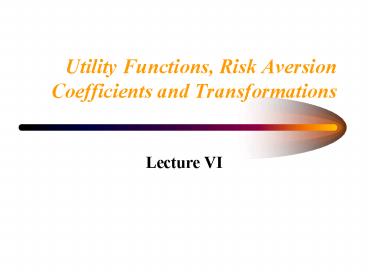Utility Functions, Risk Aversion Coefficients and Transformations - PowerPoint PPT Presentation
1 / 24
Title:
Utility Functions, Risk Aversion Coefficients and Transformations
Description:
The current study gives some guidance on using previously published risk aversion coefficients. ... Therefore, the magnitude of the risk aversion coefficient is ... – PowerPoint PPT presentation
Number of Views:351
Avg rating:3.0/5.0
Title: Utility Functions, Risk Aversion Coefficients and Transformations
1
Utility Functions, Risk Aversion Coefficients and
Transformations
- Lecture VI
2
Risk Aversion Coefficients for Specific Utility
Functions
- Quadratic Utility Function To specify the
appropriate shape of the utility function, the
quadratic function becomes
3
- Arrow-Pratt absolute risk aversion coefficient
4
- Arrow-Pratt relative risk aversion coefficient
5
- Power Utility Function
6
- Arrow-Pratt absolute risk aversion coefficient
7
- Arrow-Pratt relative risk aversion coefficient
- Constant relative risk aversion.
8
- Negative Exponential Utility Function
9
- Arrow-Pratt absolute risk aversion coefficient
10
- Constant absolute risk aversion. Arrow-Pratt
relative risk aversion coefficient
11
- HARAHyperbolic Absolute Risk Aversion
12
- Arrow-Pratt absolute risk aversion coefficient
13
- As ??1 it becomes risk neutral.
- ?2 is a quadratic.
- ??? and b1 is the negative exponential.
- b0 and ??1 is the power utility function.
14
Transformations of the Pratt-Arrow Risk Aversion
Coefficient
- To this point, we have discussed technical
manifestations of risk aversion such as where the
risk aversion coefficient comes from and how the
utility of income is derived. - I want to start turning to the question How do
we apply the concept of risk aversion?
15
- Several procedures exist for integrating risk
into the decision making process - Direct application of expected utility
- Mathematical programming using the expected
value-variance approximation - Stochastic dominance.
16
- All of these approaches, however, require some
notion of the relative size of risk aversion. - Risk aversion directly uses a risk aversion
coefficient to parameterize the negative
exponential or power utility functions.
17
- Mathematical programming uses the concept of the
tradeoff between variance and expected income. - Stochastic dominance uses measures of risk
aversion to bound the utility function.
18
- The current study gives some guidance on using
previously published risk aversion coefficients.
Specifically, the article looks at the effect of
location and scale on the risk aversion
coefficient
19
- As a starting place, we develop an interpretation
of the Pratt-Arrow coefficient in terms of
marginal utility
20
- This algebraic manipulation develops the absolute
risk aversion coefficient as the percent change
in marginal utility at any level of income. - Therefore, r is associated with a unit of change
in outcome space. If the risk aversion
coefficient was elicited in outcomes of dollars,
then the risk aversion coefficient is .0001/. - This result indicates that the decision-makers
marginal utility is falling at a rate of .01 per
dollar change in income.
21
- This association between the risk aversion and
the level of income then raises the question of
the change in outcome scale. - For example, what if the original utility
function was elicited on a per acre basis, and
you want to use the results for a whole farm
exercise?
22
- Theorem 1 Let r(x)u(x)/u(x). Define a
transformation of scale on x such that wx/c,
where c is a constant. Then r(w)cr(x). - The proof lies in the change in variables. Given
23
- In other words, if the scale of the outcome
changes by c, the scale of the risk aversion
coefficient must be changed by the same amount. - Theorem 2 If vx c, where c is a constant,
then r(v)r(x). Therefore, the magnitude of the
risk aversion coefficient is unaffected by the
use of incremental rather absolute returns.
24
- Example Suppose that a study of U.S. farmers
gives a risk aversion coefficient of r.0001/
(U.S.) Application to the Australian farmers
whose dollar is worth .667 of the U.S. dollar is
r.0000667/ Australian.






























